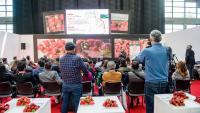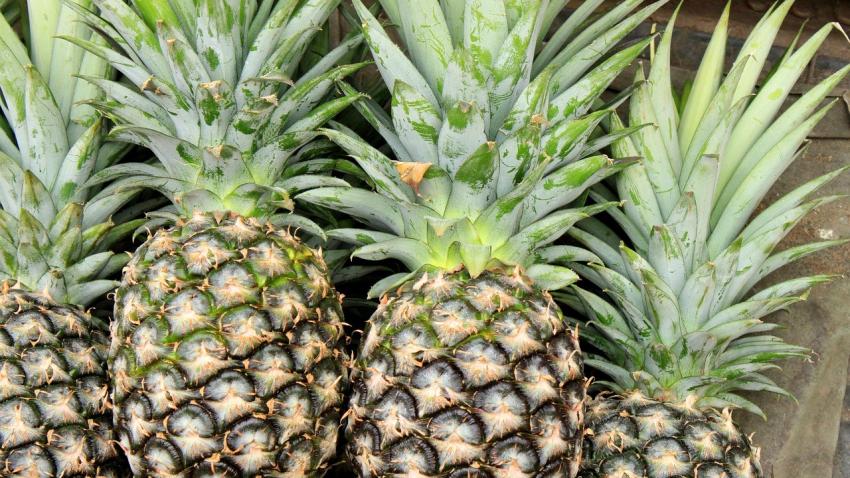You are here
Back to topPineapple under the spotlight on the second day

Rimini, 10 May 2019 – The second day of the Tropical Fruit Congress, with the focus on pineapple, the announcement of the 2020 edition of the International Strawberry Symposium and the round table on brand value. Day two of Macfruit was again crammed with data, discussions and news on the fruit and vegetable sector and its innovations.
Tropical Fruit Congress
The second day opened with the Tropical Fruit Congress’s focus on pineapple.
“The pineapple is the second most important tropical fruit after the banana,” Pierre Escodo of Eurofresh Distribution began.
In 2018, 50% of world pineapple exports were shipped from Costa Rica, with volumes of 8 million tonnes, with the Philippines in second place in the export rankings. The biggest importers are the United States, while in Europe the most important destination is the Netherlands with 318 thousand tonnes, 77% of which is then re-exported. The third largest buyer market is China (185 thousand tonnes), but Russia is also making a comeback with impressive figures, with imports growing by 16% last year alone.
“The time has come,” Mr Escodo continued, “to support this market’s long-term growth by focusing on new varieties such as baby pineapple, being aware of the new players entering the market, such as China, Ecuador and Africa, and simplifying the product consumption process and the fresh fruit segment. If, and only if, these factors are combined, there is vast growth potential for pineapple in the medium-term future.”
Quality, effective logistics, traceability, nutrition education, eco-sustainability and responsiveness to consumer trends are the directions in which international tropical fruit growers are moving.
“In Costa Rica, pineapples shipped to the United States account for 35% of agricultural exports,” Upala Agricola of Costa Rica explained, “followed by Europe and, very slowly, also by the Chinese market. If we want to expand in the future, we have to keep improving our product, to achieve larger sales volumes, as well as resolving our logistics problems with Asia and the Middle East. Without a doubt, the new challenges to be borne in mind also include the adoption of organic growing methods.”
S&W Fine food International, from the Philippines, has won the islands their place as the world’s second biggest pineapple producer: “Aware of consumers’ latest demands, three years ago we were already starting to sell pineapple cut into slices or sticks and frozen, a revolutionary product that retains the distinctive sweet flavour and the same nutritional properties as the fresh fruit.”
Italian company Dole, which launched the ‘Dole Earth’ online platform a few years ago, aims for greater quality and transparency: “Through our website, we set out to empower consumers, who can type in the five-figure code they find on the fruit itself to identity the specific plantation where the pineapple was grown. We also believe strongly in nutrition education for consumers and support for a correct lifestyle, so we have developed our ‘100% natural snacking’ messages, which identify pineapple as the perfect snack for eating at any time of day.”
Fresh products producer Robinson Fresh provided an overview of general market trends: “World pineapple output is growing, but consumption habits are changing: in general, demand for ready-to-eat product is on the increase, and the market has to adapt with creativity and new packaging solutions. In some countries, this mechanism is already up and running: for example, in the United States 54% of consumers are willing to pay more for a product that is ready to eat.”
The view from Italy was provided by Alessandro Dal Bello, Vice President of Sife, a fruit and vegetable wholesaler whose core business is the distribution of bananas and pineapples from Costa Rica: “Instead of concentrating on price, to increase pineapple sales we need to put our energies into product transformation, not forgetting the sustainability of the packagings used. Any policy we adopt must be independent of the strategies of the major chains: this is essential if earnings are to be shared throughout the supply chain.”
Confirmation of the new pineapple consumption trends also came from world market survey leader Kantar, which explained that: “In line with the tendency to prefer products that are easier to use, ready-to-eat pineapple is one of the top alternatives to conventional snacks.”
International Strawberry Symposium
The focal event of the afternoon was the round table on the International Strawberry Symposium, which is to return to Italy 32 years after it was last held here. Since 1988, when the very first International Strawberry Symposium took place in Cesena, the event has always been organised abroad. For its return to Italy, the Symposium is planning a series of appointments at different locations, with field visits from Basilicata to northern Italy, and a core congress in Romagna.
The Italian edition of the Symposium, which will welcome hundreds of researchers from all over the world, will be organised by the Crea Olive, Fruit and Citrus Research Centre (Centro di ricerca Olivicoltura, Frutticoltura e Agrumicoltura), Forlì location, and Università Politecnica delle Marche, while the logistics have been contracted, further to a public bidding procedure, to Aim Group International. “Three years ago, in Canada, we fought off strong competition from the Dutch,” Gianluca Baruzzi of Crea begins, “and this is an incredible opportunity for Italy, a showcase in which our country can display itself to the world in its best possible light, with no rivalries. It is amazing to think that the stand that hosted the round table alone displayed about a hundred specimens of 42 different varieties, from Italy’s 3800 hectares of strawberry fields.
Brand value in fruit and vegetables
To what extent does brand guide consumers’ choices in the store? What are the values and expectations in relation to branded fruit and vegetable products? These were the questions underlying the survey by SG Marketing presented at the conference on “Brand value for fruit and vegetable consumers. Experience, strategies and examples.”
The survey revealed that for consumers, the fruit and vegetable grower’s brand is a genuine value, the basis for guaranteeing consistent quality, that a mix of private labels and grower brands is essential to increase the fruit and vegetable area’s added value, and that the point of sale is still, and will continue to be, the place where the brand really comes into play.
The round table which followed heard contributions from five major players in the sector, representing a model of excellence for fruit and vegetable marketing: the VOG Consortium with the Marlene brand, La Linea Verde, Citrus L’Orto Italiano, Almaverde Bio and Consorzio di Tutela del Pomodoro di Pachino IGP.
For further information, please visit: www.macfrut.com
Elena Vincenzi/Jessica Sabatini
International press office Macfrut c/o fruitecom
















